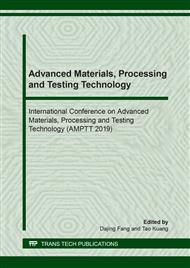[1]
Li Cong, Liu Zongzhan, Zhang Chunhui, et al. Current Status and Development Trend of Domestic Road Ice and Snow Removal Technology [J]. Mechanical Engineering & Automation. 2014(04): 68-70.
Google Scholar
[2]
Özgan E, Serin S, Gerengi H, et al. Multi-faceted investigation of the effect of de-icer chemicals on the engineering properties of asphalt concrete [J]. Cold Regions Science and Technology, 2013, 87:59-67.
DOI: 10.1016/j.coldregions.2012.11.003
Google Scholar
[3]
CTC & Associates (2011). Snow and ice control at extreme temperatures., Research report, Wisconsin Department of Transportation. Madison, WI.
Google Scholar
[4]
Pan P, Wu S, Xiao Y, et al. A review on hydronic asphalt pavement for energy harvesting and snow melting [J]. Renewable and Sustainable Energy Reviews. 2015, 48: 624-634.
DOI: 10.1016/j.rser.2015.04.029
Google Scholar
[5]
Benedetto A, Calvi A. A pilot study on microwave heating for production and recycling of road pavement materials [J]. Construction and Building Materials. 2013, 44: 351-359.
DOI: 10.1016/j.conbuildmat.2013.02.082
Google Scholar
[6]
Osborne, T.L and W. R. Hutcheson, 1989. Asphalt compounds and method for asphalt reconditioning using microwave radation, U.S. patent No.4, 849, 020(July 19, 1989).
Google Scholar
[7]
Tang Xiangwei, Jiao Shengjie, Gao Zikai, et al. Application and Analysis of Microwave Deicing [J] Road Construction Machinery and Construction Mechanization, 2008(7): 15~18.
Google Scholar
[8]
Gao Ziwei, Jiao Shengjie, Tang Xiangwei. Effect of Frequency on Microwave Heating Asphalt Mixture [J]. Journal of Chang'an University (Natural Science Edition), 2009(06): 32-36.
Google Scholar
[9]
LI Wanli, YU Ruikun, ZHU Fumin. Microwave Heating Mechanism and Numerical Simulation of Asphalt Pavement Recycling Machine [J]. Journal of Tongji University (Natural Science), 2007(04): 472-476.
Google Scholar
[10]
Tang Xiangwei, Jiao Shengjie, Gao Zikai, et al. Study on microwave deicing efficiency of winter roads [J]. Chinese Journal of Construction Machinery, 2008, 6(1): 105-110.
Google Scholar
[11]
Ding Shimin. Research on key technologies of electromagnetic absorbing concrete materials [D]. Xidian University, (2010).
Google Scholar
[12]
Zhou Shucai. Microwave Synthesis Mechanism and Thermoelectric Properties of Mg2Si Based Thermoelectric Materials [D]. Chongqing: Chongqing University, (2012).
Google Scholar
[13]
WANG Sheng, AI Tao, GAO Haijun. Analysis of Microwave Deicing Mechanism of Pavement [J]. Traffic Standardization, 2014, 42(8): 15-17.
Google Scholar
[14]
Zhao H M, Wang S G, Wu Z M, et al. Concrete Slab Installed with Carbon Fiber Heating Wire for Bridge Deck Deicing [J]. Journal of Transportation Engineering, 2010, 136(6): 500-509.
DOI: 10.1061/(asce)te.1943-5436.0000117
Google Scholar
[15]
Wang Z, Gao J, Ai T, et al. Laboratory Investigation on Microwave Deicing Function of Micro Surfacing Asphalt Mixtures Reinforced by Carbon Fiber [J]. Journal of Testing & Evaluation, 2014, 42(2): 301-310.
DOI: 10.1520/jte20130118
Google Scholar
[16]
Gao Jie. Design of carbon fiber-cement emulsified asphalt mortar heating belt and microwave deicing function [D]. Chang'an University, (2014).
Google Scholar
[17]
Zanko L M, Niles H B, Oreskovich J A. Mineralogical and microscopic evaluation of coarse taconite tailings from Minnesota taconite operations [J]. Regulatory Toxicology and Pharmacology, 2008, 52(1): S51-S65.
DOI: 10.1016/j.yrtph.2007.09.016
Google Scholar
[18]
HOPSTOCK D M. Microwave-absorbing road construction and repair material [R]. Duluth: University of Minnesota Duluth, (2003).
Google Scholar
[19]
Guo Dedong. Research on snowmelt deicing pavement technology based on coupling effect between microwave and magnet [D]. Chang'an University, (2011).
Google Scholar
[20]
Wang Sheng. Preparation and properties of absorbing asphalt mixture [D]. Chang'an University, (2014).
Google Scholar
[21]
Zanko L M, Fosnacht D R, Hopstock D M. Construction Aggregate Potential of Minnesota Taconite Industry Byproducts [J] Cold Regions Engineering 2009, 2009: 252-274.
DOI: 10.1061/41072(359)27
Google Scholar
[22]
Wang Z, Zhao P, Ai T, et al. Microwave Absorbing Characteristics of Asphalt Mixes with Carbonyl Iron Powder [J]. Progress in Electromagnetics Research M, 2011, 19: 197-208.
DOI: 10.2528/pierm11052312
Google Scholar
[23]
Zhao Peng, Ai Tao, Wang Zhenjun. A slag asphalt concrete pavement material composition for microwave heating: , CN101774786A[P]. (2010).
Google Scholar
[24]
Gallego J, Del Val M A, Contreras V, et al. Heating asphalt mixtures with microwaves to promote self-healing [J]. Construction and Building Materials, 2013, 42: 1-4.
DOI: 10.1016/j.conbuildmat.2012.12.007
Google Scholar
[25]
Liu Q, Schlangen E, Ven M V D, et al. Optimization of Steel Fiber Used for Induction Heating in Porous Asphalt Concrete[C]// International Conference on Traffic & Transportation Studies. 2010: 1320-1330.
DOI: 10.1061/41123(383)126
Google Scholar


